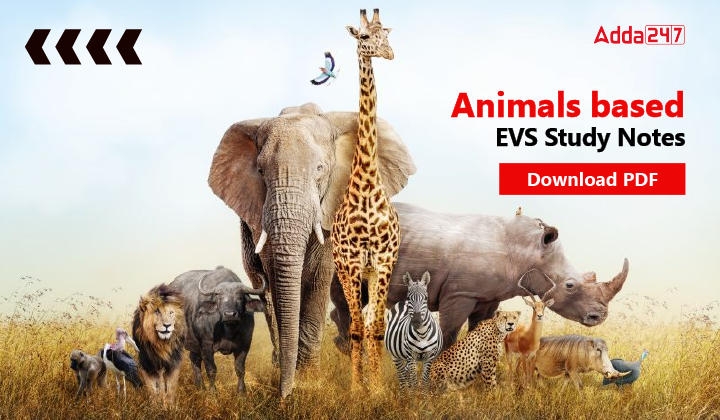Table of Contents
The Environment studies is a multi-disciplinary science comprising of various branches of studies like chemistry, physical science, life science, agriculture, health, sanitary engineering etc. Environmental Studies may be an interesting subject having 30 questions in CTET and other State TET Exams. The Environmental Science section divides its questions into two parts: Subject Content which consist of 15 marks and EVS Pedagogy which consist of 15 marks. It is advised is to study the NCERT books from class 1 to 8 of to prepare well for CTET Exam. The current article will give few important points on the topic Animals.
ANIMALS
• In our surrounding, we find different type of animals ranging from mammals, reptiles, birds, amphibian, insects and many other smaller forms.
• Animals may live on land or in water or fly in air depending upon its ability and nature. Animals are capable of movement and they move from one place to another.
• Animals have different feeding habits it may be carnivores, herbivores or omnivores.
• Animals reproduce and produce their offspring by different mode of reproduction, different animals have specific mode of reproduction depending upon its nature.
• In animals breathing and circulatory system are differently developed.
(A) Classification of Animals:
I. Classification of animals on the basis of presence of vertebral column:
• Non – Vertebrates: Absence of vertebrates or back bone. Insects, crabs, snails, starfish are example of invertebrates.
• Vertebrates: Animal having vertebral column or backbone Mammals, birds, fish, reptiles and amphibian are included in the category of vertebrates.
II. Animals are also classified on the basis of body temperature:
• Homoeothermic or Warm blooded animals: Warm blooded animal are able to regulate the temperature of body, e.g. mammals and birds.
• Poikilothermic or Cold blooded animals: Animals like reptiles, fishes, amphibians and insects are cold blooded animals as they are unable to regulate their body temperature of all types of animal living on the Earth population of insects are maximum.
III. On this basis of food habits animals can also be classified into:
• Carnivores: Animals which feeds on another animals of flesh, e.g. lion, tiger, shark, whale, eagle, vulture etc. have sharp, pointed and curved front teeth. They also have strong grinding teeth in the back of their mouth.
• Herbivores: Animals which feeds on plants and leafy materials, e.g. elephant, cow, rabbit etc. Herbivores have sharp, flat and broad front teeth. They have sharp front teeth to pluck and bite leaves of plants. These animals also have strong and flat back teeth to chew the food.
• Omnivores: Animals which feeds on both plants and flesh. e.g. dog, cat, hen, mynah, bear etc.
Some Other Types of Animals:
• Gnawers These animals have long teeth. Pair of long teeth are used to gnaw on hard foods. It is commonly present in rodent family of mammals. e.g. rabbit, squirrel. Due to continuous gnawing teeth does not become very long Inspite of continuous growth.
• Swallowing Some of the animals directly take their food and they don’t feel the need of chewing, gnawing. This eating habit is called direct swallowing
(B) Habitat of Animals:
• Land: Animals reside on the land and trees. e.g. mammals, birds, reptiles etc.
• Water: Animals resides in the water or water body, e.g. fishes, insects, crabs, sponges, snakes etc.
• Land and Water: Animals which resides and are able to reside in both land and water is called amphibian, e.g. frog, tortoise, snakes, crocodile etc.
(C) Reproduction in Animals:
• On the basis of reproduction, animals are of two types:
1. Oviparous: Animals which lies eggs e.g. birds, reptiles, amphibian, fish etc.
2. Viviparous: Animals which give birth to their young ones e.g. mammals.
• There are two kinds of fertilization in animals:
1. External Fertilization: Fertilization of ovum and sperm outside body of females. e.g. fish, frog etc.
2. Internal Fertilization: Fertilization of ovum and sperm inside the body of females. e.g. reptiles, mammals, birds etc.
• Development of embryo after the fertilization will occur inside female body of animals is viviparous other embryo will develop outside. Most of the viviparous animals have mammary glands, hair on the skin and visible cars.
(D) Breathing in Animals:
1. Animal need oxygen and energy to survive. Human and territorial mammals, birds, reptiles breathe with the help of lungs.
2. Fishes and amphibian breathe with the gills. Earthworm breath with the help of moist skin. Various other microorganisms, animals breathe through specific pore, opening or through body surface.
(E) Locomotion in Animals:
• Different animals have different structure to facilitate the locomotion. Animals translocate from one place to another in search of safety, shelter, food and mate.
• Mammals usually move with the help of legs, fish uses fins to swim from one place to another, birds’ flies with the help of wings to reach one place to another.
• Reptiles either have legs to move or it crawls with the help of body surface. Frog has webbed feet to move, Penguin uses its flippers to move and insects have many legs to move.
(F) Specific Features of Specific Class of Animals:
• Pisces/Fishes: Fishes have scales on the body. They have invisible ears and have only two chambered heart. Fishes are oviparous animal. e.g. most of the fishes.
• Amphibians: They don’t have scales on their body but they possess invisible ear. Amphibians have three chambered heart, breathe through gills, lungs and skin and amphibians as like fishes also reproduces by external fertilization so it is also oviparous animal. e.g. frog, tadpole,
crocodiles etc.
• Reptiles: Reptiles have scales on their body. They also possess invisible ear like birds and fishes. Reptiles breathe by lungs and it has three chambered heart. It also reproduces by oviparous method. e.g. snakes, lizards, tortoise etc.
• Reptiles such as snakes hear from the vibrations coming out of a surface or land, Snake do not have any external ear. They can only feel vibration from the ground. Snake has hollow teeth known as fangs.
• There are many kinds of snakes in our country, only four of them are poisonous. They are Cobra Karait, Russel’s viper (Duboiyo) and Saw – Scale viper (Afai).
Insects:
• Insects live in colony. These organisms recognize their fellow mates and other things mostly through their smell or by specific types of secretion known as pheromones, e.g. ant, bees, skill worm etc.
• Mosquitoes recognize by smell of body. They can also find human by smell of sole of feet and heat of the body.
2. Birds:
• Birds have boat shaped body, hollow bones, wings and feathers to help in flying. It sits on the branches of trees. It’s claws are made so that it helps in grasping the branches of trees. Birds have fixed eye position, so in order to see in different direction birds’ move their neck in different direction. Among all the birds owl has maximum capacity to rotate its neck up to 360° while mynah can move its neck back and forth with jerk.
• Different birds make their nest in their own way. Bulbul uses bushes with dried grass and hedges to make nest. Robin nest is made up of soft twigs, roots, wool, hair, cotton wool and grass. Robin’s nest is very soft in nature. Crow make its nest using wire, wood, grass and twigs and it makes nest high up on trees.
• Eagle, kites, vulture have strongest eyesight among birds and other animal except Tiger. These birds have four times better vision than humans.
• An egret bird sits on the body of cattle. Such kind of association is called symbiotic relation, where both organisms are mutually benefitted.
3. Mammals: These animals have hair on their body surface, mammary glands, visible ears are present, breathe through lungs and possess four chambered heart. This class of animals reproduces by viviparous method of reproduction e.g. elephant, fox, lion, human etc.
Some unique features of specific mammals are
• Tiger has great sense of sight, it can see six times better than human at night. Tiger can move its ear in different direction to catch even the slightest of sound. Tigers are able to make out difference between minor sounds.
• Tiger make different sound for different purposes. It can roar or snarl. Its roar can be heard up to 3 kilometer away. Each tiger has its own area and they mark their area by urine.
• Elephant has regular diet of 100 kg of green leafy material per day. Elephant loves to play with mud and water. It uses its ear as fan to cool it. Baby elephant is approximately of 90 kg at the time of birth.
• In the herd of elephant, oldest female is leader. A herd may have 10 – 12 female elephants and young one. In herd, male elephant is not present, it leaves the herd after attain age of 14 – 15 years and move alone. Elephant sleeps for 3 – 4 hours only.
• Dolphin has unique ability to make different sounds to communicate in water. Whale and dolphin locate their food with the help of echo. A fish shark has strongest sense of smell of blood of human among all organisms.
• Animals cannot see as many colors as we can. Animals that are awake in the daytime can see some colors, but animals that are awake at night can only see in black and white color.
4. Animal Husbandry:
It is a science of breeding and caring of animals. It is basically management of those animals which are commercially important to human. Animals give many useful products for humans.
- Cow – Milk, meat
- Buffalo – Milk, meat
- Goat – Milk, meat, wool
- Sheep – Meat, wool
- Honey bee – Honey
- Lac – insect Lac
- Silkworm – Silk fibre
- Hen, chicken – Egg, meat
- Snake – Leather
- Rabbit – Meat and fur
Bee – keeping:
• Honey bees are attracted to litchi flower. Honeybee laid their eggs from October to December. So, it is the best time to start beekeeping in the state of Bihar.
• Every bee hive has one queen bee that lay eggs. Most of the bee in the hive are worker – bees, there are also few male – bee.
Now Answer These Questions:
Q1. Animals that awake at night can see –
(a) All colors
(b) Only black and white
(c) Only red or green
(d) Can see sone colors
Q2. Which of the following creature breathe with the help of moist skin?
(a) Earthworm
(b) Fishes
(c) Sparrow
(d) Cat
Q3. The association of a cattle or erget bird is called:
(a) Asymbiotic relation
(b) Prey relation
(c) Symbiotic relation
(d) Commensalism relation
Q4. Which one of the following statements is incorrect about elephants?
(a) Elephant like to take too much rest because of their heavy bodies.
(b) A three-month-old baby elephant generally weighs about 2 quintals
(c) An adult elephant can eat even more than 2 quintals of leaves and twigs in one day
(d) Elephants sleep for 4 to 6 hours in a day.
S1.Ans. (b)
Sol. Animals that awake at daytime can see some colors while that awake at night can see in black and white color.
S2.Ans. (a)
Sol. Different creatures uses different organs to breathe. Earthworm uses their moist skin to breathe, fishes use gills to breathe and other creatures like sparrow and frogs including humans uses lungs to breathe.
S3.Ans. (c)
Sol. Egret bird sits on the body of cattle. Such kind of association is called symbiotic relation, where both organisms are mutually benefited. Cattle egrets are small, white birds that sit comfortably on the back of a cow, an ox, or a buffalo. Cattle egrets eat little bugs that bite and tend to bother the cattle.
S4.Ans. (b)
Sol. Elephants are herbivorous and can be found in different habitats including savannahs, forests, deserts and marshes. They prefer to stay near water. They can consume as much as 150 kg of food and 50 L of water in a day. The weight of the baby of elephant is approximately 90 kg at the time of birth.Except B option all statement are correct about elephants.
DOWNLOAD EVS STUDY NOTES PDF – In English
DOWNLOAD EVS STUDY NOTES PDF – In हिंदी
You may also like to read :



 CG TET Syllabus 2024 and New Exam Patter...
CG TET Syllabus 2024 and New Exam Patter...
 SCERT DELED Application Form 2024, Eligi...
SCERT DELED Application Form 2024, Eligi...
 CTET Exam 2024: Dates, Times, Shifts &am...
CTET Exam 2024: Dates, Times, Shifts &am...








